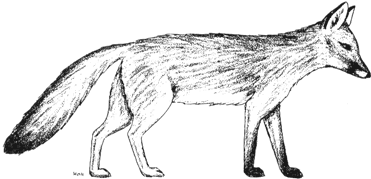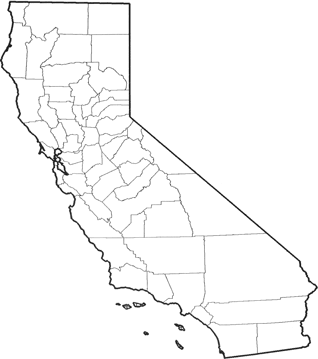
Island Gray Fox
Distribution, Abundance, and Seasonality
The island gray fox is restricted to 6 of the Channel Islands off the coast of southern California. Common on Santa Cruz, Santa Rosa, and San Clemente islands, less common on San Nicolas and San Miguel, and rare on Santa Catalina. Optimum habitats are mixed chaparral, coastal scrub, and shrubby stages of valley foothill woodland (Von Bloeker 1967, Laughrin 1973, 1980).

Range Map
Specific Habitat Requirements
Feeding: This omnivore feeds on small mammals, fruits, berries, insects, carrion, birds, eggs, nestlings, and crabs. Several fruits are consumed, including Catalina cherry, toyon, elderberries, prickly pears, and acorns. Saltbush and iceplant also are eaten. Plant material and insects had the highest frequency of occurrence in diet studies (Laughrin 1973, 1977). Forages on the ground and climbs shrubs, forages on beaches for carrion and invertebrates, and on cliffs for seabird eggs and young.
Cover: Seeks cover in burrows, dense brush, and rocky areas (Philbrick 1967, Power 1980).
Reproduction: Dens in burrows, hollow stumps, or logs, and under rocks. Usually does not excavate own den (Laughrin 1973).
Water: No data found. Presumably drinks available water.
Pattern: Prefers more complex, layered vegetation, with a high density of woody, perennial fruiting shrubs. Prefers rocky places and dense brush for cover.
Species Life History
Activity Patterns: Active yearlong. Foraging peaks are in the early morning and late afternoon and evening, but may be active at any time of day (Laughrin 1973). Least active at midday and very early morning.
Seasonal Movements / Migration: None.
Home Range: Roughly 0.08 km? (0.05 mi?) (Laughrin 1973). Home ranges of young animals are larger; animals in their reproductive prime are relatively sedentary. Densities ranged from 0.2/km? (0.3/mi?) on Santa Catalina to 19.8/km? (33/mi?) on Santa Cruz (Laughrin 1973).
Territory: No data found. Mainland gray foxes generally have non-overlapping home ranges, with each home range occupied by a pair (Fritzell and Haroldson 1982).
Reproduction: Mating occurs mostly from February to early March, but may occur as late as May. Gestation is about 50 days. The young are born in late April and May, with a peak in the first wk of May. Litter sizes range to 5, with most pairs raising 2 young to maturity each year. There is 1 litter per yr. The parents begin forcing the young to be independent in August or September (Laughrin 1973). Unlike mainland gray foxes, island fox populations have a relatively high proportion of individuals over 2 yr old.
Niche: This small omnivore is ecologically similar to the gray fox (Fritzell and Haroldson 1982). Probably preyed on by hawks and eagles. Populations may be reduced by the effects of introduced species, competition with introduced cats, and human activities. Carries calcivirus (San Miguel sea lion virus) (Prato et al. 1977).
Comments: Impacts on fox populations, recovery efforts, and land ownership on the Channel Islands are reviewed in California Dept. Fish and Game (1980a). Separate subspecies have been described for each island.
Sources & References
California Department of Fish and Game, 1999.
California's Wildlife, Sacramento, CA.
Written by: V. Johnson, reviewed by: H. Shellhammer, edited by: R. Duke, J. Harris
California Department of Fish and Game. 1980a. At the crossroads: a report on the status of California's endangered and rare fish and wildlife. Sacramento. 149pp. Fritzell, E. K., and K. J. Haroldson. 1982. Urocyon cinereoargenteus. Mammal. Species. No. 189. 8pp. Grinnell, J., J. S. Dixon, and J. M. Linsdale. 1937. Fur-bearing mammals of California. 2 Vols. Univ. California Press, Berkeley. 777pp. Ingles, L. G. 1965. Mammals of the Pacific states. Stanford Univ. Press, Stanford, CA. 506pp. Laughrin, L. 1973. California island fox survey, 1973. Calif. Dep. Fish and Game, Sacramento. Wildl. Manage. Branch Adm. Rep. 73-3. 17pp. Laughrin, L. 1977. The island fox: a field study of its behavior and ecology. Ph.D. Diss., Univ. Calif., Santa Barbara. 83pp. Laughrin, L. 1980. Populations and status of the island fox. Pages 745-749 in D. M. Power, ed. The California islands. Santa Barbara Mus. Nat. Hist. 787pp. Philbrick, R. N., ed. 1967. Proceedings of the symposium on the biology of the California Islands. Santa Barbara Botanic Garden. 363pp. Power, D. M., ed. 1980. The California islands. Santa Barbara Mus. Nat. Hist., Santa Barbara, Calif. 787pp. Prato, C. M., T. G. Akers, and A. W. Smith. 1977. Calcivirus antibodies in wild fox populations. J. Wildl. Dis. 3:448-450. Von Bloeker, J. C., Jr. 1967. The land mammals of the southern California Islands. Pages 245-263 in R. N. Philbrick, ed. Proc. Sympos. on the Biology of the California Islands. Santa Barbara Botanic Garden, Santa Barbara. 363pp.
California Animal Facts | California's Wildlife